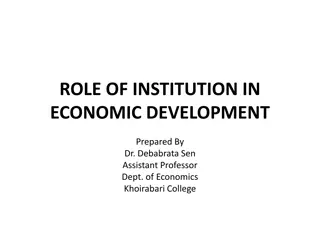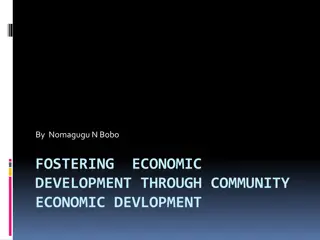Economic Gordian Knot and National Development Challenges
The National Development Plan 1 reflects on the challenges posed by the Economic Gordian Knot in South Africa. Issues such as uncompetitive product and labor markets, low investment, high inequality, and poor skills profile hinder economic growth and employment. The plan identifies the difficulty in addressing these issues and suggests strategies for progress.
Download Presentation

Please find below an Image/Link to download the presentation.
The content on the website is provided AS IS for your information and personal use only. It may not be sold, licensed, or shared on other websites without obtaining consent from the author.If you encounter any issues during the download, it is possible that the publisher has removed the file from their server.
You are allowed to download the files provided on this website for personal or commercial use, subject to the condition that they are used lawfully. All files are the property of their respective owners.
The content on the website is provided AS IS for your information and personal use only. It may not be sold, licensed, or shared on other websites without obtaining consent from the author.
E N D
Presentation Transcript
Reflections on Chapter 3 on the National Development Plan 1
Economic Gordian Knot Uncompetitive product markets Low investment, low growth, low employment and high inequality Poor skills profile Uncompetitive labour markets Low savings 2
Economic Gordian Knot Product markets are uncompetitive due to history of isolation and siege mentality of the apartheid economy. This leads to high profit margins but low investment and innovation. It also stifles new firm entry. Uncompetitive labour markets keep new entrants out, with workers and capital sharing in the high profits. This leads to low employment and skews the economy towards skills intensive, high productivity sectors. Low savings mean that we are reliant on foreign capital inflows, which reinforce the oligopolistic nature of the economy. Capital chases high returns and also leads to high dividend outflows. Low skills profile and pattern of growth pushes up skills premiums, leading to labour market mismatch and high wage inequality. 3
What to do about it is not obvious If we liberalise labour markets, we may well get even higher profits but no increase in investment or employment Liberalising product markets is hard and if we did, we may get lower profits and even lower savings (investment) Fixing the skills system is difficult and long term Raising savings too quickly will lead to lower consumption and a fall in employment and growth in the short term Growing exports may reduce reliance on foreign capital inflows but it may also just accelerate them, leading to overheating 4
Why so little progress so far Redistribute money Greater impact Redistribute assets (e.g. Housing) Harder to do Broaden reach of quality education Create work for unskilled people 5
Targets and milestones Reduce gini coefficient to 0.6 Raise proportion of national income going to bottom 40% to 10% of GDP Increase employment from 13 million to 24 million Unemployment from 25% in 2011 to 14% in 2020 to 6% in 2030 (with rising labour force participation) Average GDP growth of about 5.4% a year to 2030 Increased gross fixed capital formation to 30% of GDP by 2030 Of this, public infrastructure spending to 10% of GDP Reduce proportion of people in poverty (R419 per person per month in 2009 rands) to zero Are these realistic? 6
Overall philosophy of the Economy and Employment chapter Progress on broad front of activities State capacity, skills, spatial planning, health etc Focus on areas of comparative advantage to generate resources to upgrade capabilities for tomorrow s economy Capabilities cover skills, economic infrastructure and institutions Areas of comparative advantage Mining, financial services, mid-skill manufacturing, agriculture ands agro- processing, higher education, IT enabled services Raise investment public and private Raise net exports Enhance competition Reform labour market Theory of change Productivity growth in the tradable sector will generate jobs in smaller and more domestically oriented sectors (where about 90% of jobs are likely to be created) 7
Possible solutions Any solution has to be a long term solution, applied over time with results seen in decades not years Options include Raise exports, but also raise government savings to prevent overheating or currency appreciation Within a floating exchange rate regime, intervene more aggressively to prevent excessive overvaluation Import many more skilled workers, reducing the premium for skilled workers, reducing inequality and enabling the skills intensive sectors to grow faster Regulate monopoly upstream industries, though doing this sensibly is difficult and risky Deregulate telecoms, ICT and parts of the energy sectors Run a budget surplus, but give large guarantees to the SOEs for capital investment Subsidise labour or labour intensive industries and provide greater labour market flexibility in labour intensive industries 8
Policies that will not work Fixing the exchange rate will not work because our uncompetitive product and labour markets will mean that prices will rise to render us uncompetitive, ala Greece We have too low a savings rate to intervene too heavily in the currency Curbing capital inflows might be necessary under extreme circumstances, but has not worked in Brazil it has actually led to more pro-cyclicality in the exchange rate Curbing capital outflows we do curb capital outflows. To do more would quickly result in less capital inflows, leading to a balance of payments crisis General tariff increases or export taxes to encourage beneficiation will raise the cost structure of the economy, appreciating the real exchange rate, ultimately reducing exports Nationalisation will result in both capital outflows, which we cannot afford, and lower investment in the economy in general Wholesale labour market liberalisation is likely to result in social instability that would outweigh any competitiveness or employment gain 9























